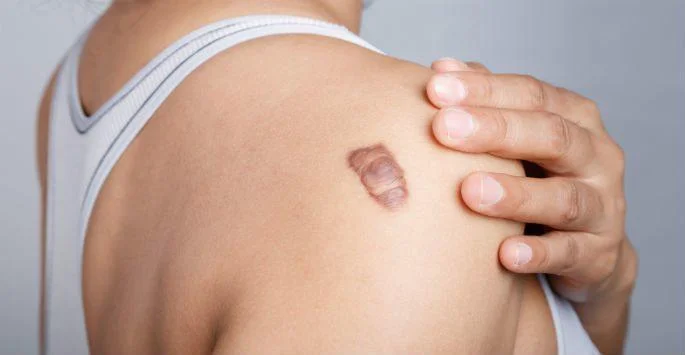
A keloid scar is an overgrowth of scar tissue that sometimes forms after a cut or other event that results in trauma to the skin has healed. It is uncertain why these scars form, and they do not form every time there is an injury to the skin. They do seem more likely in people between 10 and 30 years of age. People with darker skin tones are also more likely to get them. While they mostly form at the site of an injury, there have been cases of keloid scars that form when there was no history of any illness or injury that caused skin damage.
Some of the most well-known causes of keloid scars are:
People who have one of these scars are sometimes more likely to develop them in other places on the body. This is because some individuals are more prone to having them than others.
Keloid scars stick up from the skin and become rounded, elevated surface areas as they grow. They are usually pink, purple or brown and typically look shiny. They sometimes have a rubber-like feel. Occasionally, they can be uncomfortable due to itching and tenderness. In most cases, however, they have no impact on the person’s health. There can be times, though, when they interfere with the range of motion if they are located directly over a joint. The biggest issue with them in most people’s minds is their appearance.
Medical professionals can diagnose keloid scars simply by looking at them. When they begin to appear, they will continue to grow until they reach their full development. This can be a slow process, lasting years in some cases.However keloids can wax and wane in their size and activity ove time.
For preventative measures, there are some things that can be done for people whose history indicates that they are prone to the development of keloid scars. Whenever they are scheduled for a surgical procedure or suffer an accidental skin laceration, the wound can be covered with hypoallergenic paper tape or a silicone gel for several weeks. The most important thing to do is to frequently surveillance your scar especially over the first 12-24 months for changes in size, depth and appearance. Early treatment of keloids is important because the defect is small and less “eye catching” and thus early intervention will lead to the smallest skin blemish or defect. Other preventive measures that are done from time to time include serial corticosteroid injections during the early stages of healing and or once the keloid is active. However steroid treatments can cause keloids to get bigger. For difficult keloids excisional therapy paired with steriod injection therapy and/or low dose superficial radiation therapy can also be used. The therapy for keloids are not always covered by insurance carriers.
Cost for Keloid Therapy treatment:
If requested, we provide you with a insurance HIVA form so that you can be reimbursed by your insurance carrier. Consultations and treatments are paid by the patient. This model has worked well and allowed Dr. Lissa’s practice to provide excellent preventive and clinincal treatments for her patients. When appropiate Dr. Lissa uses her patient’s insurance to deray and decrease her patient’s out of pocket expense when this is possible.
We’re here to help, with a number of patient resources designed to make your experience as comfortable as possible. Read through the materials below, and don’t hesitate to reach out and set up your consultation to learn more about what we can do for you.